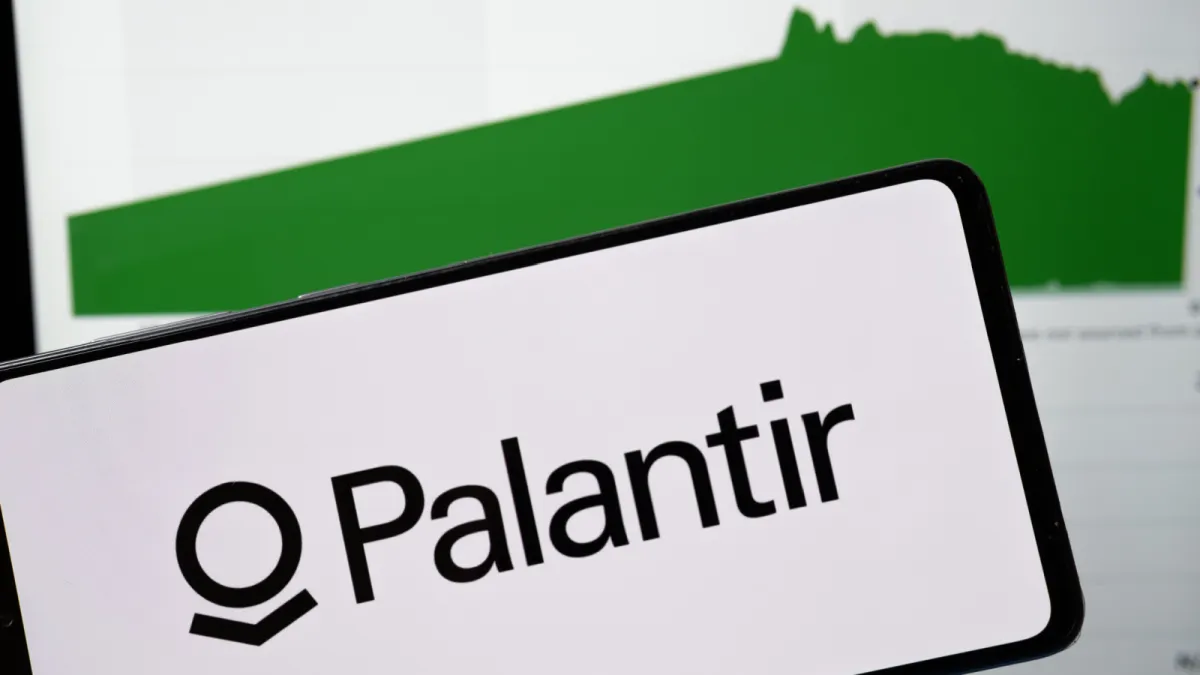Palantir Technologies Inc. (PLTR) Q4 Earnings Call: Is Its Bull Run Over?

Executive Summary
Core Business Overview
- Palantir Technologies Inc. (PLTR) reported exceptional Q4 results with revenue growing 14% sequentially and 36% year over year, and 29% year over year for the full year. The company closed $1.8bn of TCV across its business in Q4, a 56% increase year over year, including 32 deals worth $10mn or more. US business grew 52% year over year in Q4, with US commercial revenue growing 64% year over year and 20% sequentially.
- Palantir's foundational investments in ontology and infrastructure have positioned the company to uniquely deliver on AI demand. The company viewed LLMs as a new runtime for AI labor, recognizing that chat was a dead end. To capture the productive value of AI labor, an intermediate representation of the enterprise that AI can interact with is needed. The intermediary representation that makes enterprise AI interaction possible is ontology, which has been the secret to Palantir's meteoric rise.
- Palantir's international commercial business continues to see pockets of growth alongside large renewals of long-standing customers. Rio Tinto extended their partnership for an additional 4 years, noting AIP is making their unstructured data accessible. Network Rail specialists are using Palantir's software to coordinate 53 driverless trains, improving throughput and safety. The company continues to capitalize on targeted growth opportunities in Asia, the Middle East, and beyond, but remains focused on accelerating growth in the US commercial business.
- Customer count grew 43% year over year and 13% sequentially to 711 customers. Fourth quarter trailing 12-month revenue from the top 20 customers increased 18% year over year to $65mn per customer. The US commercial customer count grew to 382 customers, reflecting growth of 73% year-over-year and 19% sequentially. Net dollar retention was 120%, an increase of 200 basis points from last quarter, driven by expansions at existing customers and new customers acquired in Q4 2024 as the company sees the effect of the AI revolution.
- AIP continues to fuel new customer acquisition for Palantir, with nearly 5 times the number of US commercial customers compared to 3 years ago. The company is seeing significant expansion opportunities at existing customers, with organizations looking to replicate success across their operations. Palantir announced customers in the inaugural Warp Speed cohort, using Palantir's Warp Speed to gain advantages in manufacturing operating systems. Anduril CIO Tom Bosco noted up to 200x efficiency gain in their ability to anticipate and respond to supply shortages using the software.
- Palantir's US government business grew 45% year over year in Q4. Notable deals included the US Army extending its partnership for the Army Vantage capability and a contract expansion with US Special Operations Command, marking the first deployment of Mission Manager to US Special Operations Forces units. Revenue increased 26% sequentially last quarter, largely due to UK expansion, including work with the NHS to roll out the federated data platform. As of November 2024, 87 acute NHS trusts and 28 integrated care boards have signed up to use it.
Financial Breakdown
- In Q4, Palantir reported stock-based compensation expense of 282mn, with employer-related equity tax expense of 80mn. GAAP operating income was 11mn (1% margin), while excluding one-time SAR-related expenses, it was 142mn (17% margin). GAAP net income was 79mn (10% margin), and 165mn (20% margin) excluding one-time SAR-related expenses. GAAP EPS was 3 cents, and 7 cents excluding one-time SAR-related expenses. Adjusted EPS was 14 cents.
- For the full year, stock-based compensation expense was 692mn, and employer-related equity tax expense was 126mn. GAAP operating income was 310mn (11% margin), and 442mn (15% margin) excluding one-time SAR-related expenses. GAAP net income was 462mn (16% margin). GAAP EPS was 19 cents, while adjusted EPS was 41 cents. The company generated 1.15bn in cash from operations and 1.25bn in adjusted free cash flow, representing margins of 40% and 44%, respectively.
- Fourth quarter revenue grew 36% year over year and 14% sequentially to $828mn. Full year revenue grew 29% year over year to $2.87bn. Full year US revenue grew 38% year over year to $1.9bn. Excluding the impact of revenue from strategic commercial contracts, fourth quarter revenue grew 39% year over year and 14% sequentially, and full year revenue grew 32% year over year. Adjusted gross margin, excluding stock-based compensation expense, was 83% for the quarter and the full year.
- Fourth quarter commercial revenue grew 31% year over year and 17% sequentially to $372mn. Full year commercial revenue grew 29% year over year to $1.3bn. Excluding the impact from strategic commercial contracts, fourth quarter commercial revenue grew 37% year over year and 18% sequentially, and full year commercial revenue grew 36% year over year. Fourth quarter government revenue grew 40% year-over-year and 11% sequentially to $455mn. Full year government revenue grew 28% year-over-year to $1.57bn.
- Revenue growth accelerated to 36% year over year, exceeding the high end of prior guidance by over 900 basis points and representing a 1,600 basis point increase compared to the growth rate in Q4 of 2024. America continues to rapidly embrace the AI revolution, driving impressive outperformance in the US business, which grew 52% year over year and 12% sequentially. The US commercial business grew 64% year over year and 20% sequentially, while the US government business grew 45% year over year and 7% sequentially.
- Palantir expanded adjusted operating margin to 45%, the strongest in the company's history. The revenue and profitability drove a 13-point sequential increase to a Rule of 40 score from 68 in the third quarter to 81 in the fourth quarter. The company had an exceptional cash flow quarter with adjusted free cash flow of $517mn, representing a margin of 63%, and $1.25bn in adjusted free cash flow for the full year, representing a margin of 44%.
Performance Review
- Palantir's combined revenue growth and adjusted operating margin accelerated to 81% in Q4, a 13-point increase to their Rule of 40 score from the prior quarter. The company reported 29% growth in aggregate, 38% growth in the US, and 54% growth in US commercial. Their Rule of 81 significantly exceeded the Rule of 40, potentially necessitating a new benchmark.
- In Q4, Palantir generated 460mn in cash from operations and 517mn in adjusted free cash flow, representing margins of 56% and 63%, respectively. Through the end of Q4, the company repurchased approximately 2.1mn shares as part of their share repurchase program. As of the end of the quarter, 936mn remains of the original authorization. Palantir ended the quarter with 5.2bn in cash, cash equivalents, and short-term US treasury securities.
- Fourth quarter US commercial revenue grew 64% year-over-year and 20% sequentially to $214mn. Full year US commercial revenue grew 54% year-over-year to $702mn. Excluding revenue from strategic commercial contracts, fourth quarter US commercial revenue grew 76% year-over-year and 19% sequentially, while full year US commercial revenue grew 69% year-over-year. Fourth quarter US government revenue grew 45% year-over-year and 7% sequentially to $343mn. Full year US government revenue grew 30% year-over-year to $1.2bn.
- Fourth quarter international commercial revenue grew 3% year-over-year and 15% sequentially to $158mn, partially driven by revenue catch-up from a customer in Asia. Full year international commercial revenue grew 9% year-over-year to $594mn. Fourth quarter international government revenue grew 28% year-over-year and 26% sequentially to $112mn, bolstered by continued work in UK healthcare and defense. Full year international government revenue grew 23% year-over-year to $372mn.
- Palantir ended the fourth quarter with $5.43bn in total remaining deal value, an increase of 40% year-over-year and 20% sequentially, and $1.73bn in remaining performance obligations, an increase of 39% year-over-year and 10% sequentially. Q4 adjusted expense was $455mn, up 1% sequentially and 14% year-over-year, and full year adjusted expense was $1.74bn, up 9% year-over-year, primarily driven by continued investment in AIP and technical talent.
- The company accelerated $131mn of one-time expense in the fourth quarter related to employee stock appreciation rights (SARs). Palantir expects a more significant increase in expense in 2025 as it invests in technical hires, the product pipeline, and continues its focus on AI production use cases, while delivering goals of sustained GAAP profitability.
Products & Pipeline
- Palantir signed a $67mn TCV engagement with one of America's largest pharmacies for workflows including automatically load balancing prescription fulfillment and orchestrating patient outreach. An American telecom company signed a $40mn TCV expansion deal to manage and accelerate decommissioning of old network technologies. A leading global insurance organization signed a nearly $11mn ACV expansion deal in Q4 after deploying AIP to automate underwriting workflows.
- Palantir is working with various companies to implement AI solutions. With a large multinational bank, they've automated core back office processes, reducing a 5-day process to 3 minutes. For a top engineering and construction firm, they're automating risk identification in technical documents. With a large power systems company, they're automating the understanding of technical diagrams for quotes and orders. For an automotive supplier, they're analyzing CAD files to validate engineering standards and manufacturability checks, automating a 100-hour process for human engineers.
- Palantir had its strongest quarter of commercial TCV booked at $995mn, representing 42% growth year over year and 63% growth sequentially. The US commercial business is seeing unprecedented demand with AIP driving both new customer conversions and existing customer expansions in the US. Palantir had its strongest quarter of US commercial TCV booked at $803mn, representing growth of 134% year-over-year and 170% sequentially. This exceeded the next highest quarter of US commercial TCV booked by nearly $400mn, highlighting the increased demand for AI production use cases.
- Total remaining deal value in the US commercial business grew 99% year-over-year and 47% sequentially. Fourth quarter TCV booked was $1.79bn, up 56% year-over-year and 63% sequentially. The acceleration in government revenue was driven by continued execution in existing programs and new awards reflecting the growing demand for AI in government software offerings.
- Palantir announced its first cohort of warp speed customers, including Andrew and L3 Harris, with an exceptional response and swelling pipeline. Warp speed integrates engineering, test production, quality, and operations for faster and better manufacturing. The FedStart offering achieved a major milestone with the approval of FedRamp High environment, accelerating market access for software companies in the federal space.
- Maven is seeing significant adoption in its pathfinding new AI capabilities throughout the kill chain. Substantial new investments integrating contested logistics into Maven's AI-enabled kill chain met their moment in exercises in Q4. Adoption continues within the military departments, specifically Army, Air Force, and Space Force, as well as at the combatant commands with expansions at SpaceCom, SouthCom, Africom, and StratCom.
Near-term Plans
- For Q1 2025, Palantir expects revenue between 858mn and 862mn, and adjusted income from operations between 354mn and 358mn. For full-year 2025, the company expects revenue between 3.741bn and 3.757bn, US commercial revenue in excess of 1.079bn (representing a growth rate of at least 54%), adjusted income from operations between 1.551bn and 1.567bn, adjusted free cash flow between 1.5bn and 1.7bn, and GAAP operating income and net income in each quarter of 2025.
- Palantir emphasized their long-term strategy of building products that their partners in the West, particularly in the US, ought to have, rather than what was mandated or expected by investors or analysts. This approach aimed to generate significant value, resulting in a massive, impactful company that could power the West's infrastructure and expose inefficiencies.
- Revenue from strategic commercial contracts was $9.6mn for the quarter. The company anticipates first quarter 2025 revenue from these contracts to decline to between $4mn to $6mn compared to $24mn in the first quarter of 2024. For 2025, revenue from these contracts is expected to be approximately half of 1% of full year revenue. This indicates a shift in focus towards other revenue streams and potentially new strategic initiatives.
- Adjusted income from operations, excluding stock-based compensation expense and related employer payroll taxes, was $373mn, representing an adjusted operating margin of 45%. Full year adjusted income from operations was $1.13bn, representing a margin of 39%. These figures suggest a focus on maintaining strong operational efficiency and profitability in the near term.
- Palantir is guiding to a full year 2025 revenue midpoint of $3.749bn, representing a 31% year over year growth rate. The company is just getting started with Maven and has an ambitious roadmap and a set of customer opportunities to deliver the unfair advantage warfighters deserve.
- Hurricane Helene response galvanized the adoption of Maven on unclassified beyond just the secret and top-secret networks. The adoption has continued to grow as Maven is used for securing our nation's border and airspace by enabling drone domain awareness. Maven is reaching allies and partners via US supply capabilities called Maven REL, all spurred by real-world events and the need to collaborate in real time in crisis.
Supporting Info
- Palantir is convinced that the normative value for AI is enterprise autonomy, the self-driving company, where users go from performing workflows to supervising an army of agents, teaching them to handle edge cases and reducing dwell time.
- Palantir's deep investments in CJADC2 continue to deliver results. The company accelerated through the end of the year and remains full throttle in the winner-take-all AI economy.
- The AI revolution continues to transform industries and redefine organizational operations, becoming a pivotal component in driving innovation and efficiency. Companies must embrace AI or risk falling behind competitors. This shift is causing a significant increase in the raw AI labor supply due to the proliferation of AI models. Simultaneously, the market focus is transitioning from AI supply (the models) to demand-side considerations. Over the past 2 years, attention has been primarily on model development, but with releases like DeepSeek R1, a consensus is forming that LLM performance across open and closed source platforms is converging, while inference costs per token are dropping substantially.
- Despite the rapid advancements in AI technology, many organizations face significant hurdles in deploying Large Language Models (LLMs) into production environments with meaningful impact. A substantial number of companies find themselves on the wrong side of a widening chasm, struggling with planning processes that quickly become outdated and failing to take decisive action. This gap between AI potential and practical implementation highlights the complexity of integrating cutting-edge AI solutions into existing business operations and the need for more agile, adaptive strategies in AI adoption.
Q&A Section
Q1: What was Palantir Technologies Inc.'s most successful interest, and how does it relate to AI and large language models?
Palantir Technologies Inc. (PLTR)'s most successful interest was in figuring out how to power human-driven analytics with the assumption that future developments would be AI-driven, potentially involving large language models. Palantir Technologies Inc. (PLTR) delivered to the market a symbiotic relationship between data, computers, and LLMs, organized and made valuable by what they called an ontology. This ontology, and Palantir Technologies Inc. (PLTR)'s willingness to stick to their approach, was built on the assumption that the power of large language models would be in their ability to operationalize them in the context of the enterprise in common language. This revolution, which Palantir Technologies Inc. (PLTR) saw, built against, led, and got off the ground in America, resulted in 54% growth in US commercial business. Additionally, US government business has reaccelerated, growing 30%, with guidance above 30% at 31%, despite a very complicated environment.
Q2: How is Palantir Technologies Inc. performing in different regions, and what is the company's perspective on the future?
In the US, Palantir Technologies Inc. (PLTR) is experiencing strong growth, with 54% growth in US commercial business and over 30% growth in US government business. However, despite their best efforts, growth in continental Europe is described as anemic, with around 4% growth on 13% of the company. Palantir Technologies Inc. (PLTR) observes that Europe seems to look to the past as a way of getting to the future and struggles with the idea that valuable technology in this area is built in America. The company believes they are at the beginning of their trajectory and plans to be a cornerstone company in driving a revolution in the US over the next 3 to 5 years. Palantir Technologies Inc. (PLTR) is focused on exporting their culture and way of doing things to enterprises, especially in America, by allowing enterprises to capture their tribal knowledge in a way that they can utilize LLMs. The company is proud of its moral stance and is very optimistic about the future of the US and their role in it.
Q3: What is unique about Palantir Technologies Inc.'s ontology, and how does it provide an edge over competitors?
Palantir Technologies Inc. (PLTR)'s ontology is unique and essential in the context of AI and enterprise software. While building software for a single company or traditional enterprise software doesn't necessarily require an ontology, Palantir Technologies Inc. (PLTR)'s ambition to build software that works across government and 50 different industries necessitates it. The ontology provides superpowers when interacting with customers and helps customers manage change in their enterprises, mergers and acquisitions, and market competition. In the context of AI, the ontology serves as an intermediary representation that makes enterprises accessible to AI in a governed, secure, and observable manner. This observability is crucial for both the enterprise and regulators to trust the transition to AI-driven operations. The ontology also allows for managing large language models at scale, enabling more exact and manageable use of AI in enterprise contexts. It helps in resegmenting and recombining large language models in a way that provides exact enough information for real results in enterprise contexts. This approach, which Palantir Technologies Inc. (PLTR) likens to creating pipelines on the Foundry backend, allows for the effective use of AI in enterprises by making use cases specific enough to provide actionable results.
Q4: How does Palantir's approach to AI implementation differ from traditional methods, and why is it challenging to replicate?
Palantir's approach to AI implementation is unique and difficult to replicate due to several factors. The company has leveraged lessons from every product they've built, including security models and enterprise data interaction methods. They've developed a way to work with large language models as they actually are, not as one might wish them to be. This process is lengthy and complex, especially when creating a productized form. Many tech companies haven't figured this out because they typically focus on their own needs rather than creating a versatile product. Palantir's ability to install their system anywhere stems from a specialized, dedicated product-building culture with a deep understanding of enterprise needs. Furthermore, to teach large language models to extract precise information, secure and cleaned access to underlying enterprise data is necessary. Palantir uniquely possesses this level of access, positioning them to leverage AI capabilities effectively across various enterprises.
Q5: How does Palantir view the current state of AI development globally, particularly in relation to China?
Palantir views the current state of AI development as an arms race, particularly with China. The company acknowledges that AI models are becoming commoditized, improving across both closed and open systems, and becoming more similar, with inference costs rapidly decreasing. Palantir sees this situation as a multifaceted conflict, extending beyond just AI. They point to issues such as the fentanyl crisis, China's Belt and Road Initiative, and potential sabotage of undersea cables as evidence of a broader conflict. While recognizing China's impressive engineering capabilities, as demonstrated in models like DeepSeek-MoE, Palantir also suspects intellectual property theft and sanction evasion. The company believes that winning the AI race will require a comprehensive national effort extending beyond just the Department of Defense, emphasizing that the time to mobilize is now.
Q6: How are customers responding to Palantir's AI initiatives, and what surprises have emerged in the sales process?
Customer response to Palantir's AI initiatives has been remarkably positive, with rapid adoption and quick sales cycles. Customers are seeing significant impacts, such as reducing back-office processes at major banks from 5 days to under 3 minutes, or automating 100-hour processes in automotive supply chains. This tangible impact is driving customers to move quickly, start implementations rapidly, and expand their use of Palantir's technology to stay ahead of competitors. What has surprised Palantir is the stark difference in approach between American companies and those in other regions, particularly Europe. American companies have approached the AI revolution pragmatically, often trying multiple solutions including Palantir, and focusing on output and efficiency. There's significant communication between enterprises in America, especially within sectors, about what's working. In contrast, Europe, which represents 13% of Palantir's business with a 4% growth rate for 2024, has seen slower adoption, with some companies still approaching tech installations as they did in the 1950s. This disparity in adoption rates and approaches between regions has been particularly striking to Palantir.
Q7: How is Palantir positioned to capitalize on potential disruptions, such as changes in administration, focus on efficiencies, software modernization, and digitalization?
Palantir is optimistic about potential disruptions and changes in the government landscape. The company senses a significant amount of fear among traditional system integrators and providers. Palantir's real competition is not other companies, but rather a lack of accountability in government, particularly regarding "forever software projects" that cost billions of dollars and fail to deliver results. These projects are often considered sacred cows of the deep state. In contrast, Palantir's solutions have been preferred by soldiers in war zones because they work effectively and cost significantly less. The company believes that potential changes in administration could bring meritocracy and transparency to government, which aligns with Palantir's approach in the commercial sector. Palantir's work in government is deeply operational and valuable, and the company is excited about the prospect of exceptional engineers being able to examine and improve these systems. Ultimately, Palantir thrives on disruption, believing that what is good for America will be good for Americans and very good for Palantir. The company expects to see unexpected developments and is planning to capitalize on these opportunities, maintaining an optimistic outlook on the U.S. environment.
Q8: Where does Palantir invest to ensure it can execute on increasing demand? Is it in talent, sales, engineers, or other areas?
Palantir's primary focus for investment is on quality engineering. The company recognizes that the increasing demand and the power of their solutions are breaking down institutional barriers and political obstacles that they previously struggled to overcome. This shift is driving Palantir's strong performance in the U.S. commercial sector, as evidenced by their guidance for 2024 and 2025. The company attributes this success to their ability to maintain their culture and adhere to their core principles, which they refer to as the "ontology of Palantir." Importantly, Palantir emphasizes that they do not need to rapidly expand their workforce, stating that they don't require "500 extra people a quarter." Instead, they can effectively power their solutions because the demand from clients who see the results is sufficient to overcome institutional resistance. This approach allows Palantir to maintain its culture while delivering powerful results.
Q9: How does Palantir's approach differ in the U.S. commercial sector compared to other markets, and what drives its success?
In the U.S. commercial sector, Palantir has observed a significant shift in client expectations and responses. Clients are finding that Palantir's solutions work faster and more effectively than anticipated, often delivering results in a fraction of the time expected - sometimes in one-tenth, one-twentieth, or even one-fiftieth of the initially projected timeframe. This rapid delivery of results has become increasingly difficult for enterprises to ignore or hide within specific departments. In the past, Palantir's unconventional approach and lack of traditional business practices (such as not engaging in steak dinners or wearing suits) sometimes led to their solutions being underutilized or unacknowledged within client organizations. However, the power and effectiveness of their products have now become too significant to overlook. This shift is driving Palantir's strong performance in the U.S. commercial sector, with the company guiding to 54% growth for 2024 and 2025.
Q10: How is Palantir Technologies Inc. approaching its hiring strategy, particularly in terms of quality versus quantity of engineers, and what are the expectations for headcount growth in 2025?
Palantir Technologies Inc. (PLTR) is focusing on hiring quality engineers rather than prioritizing quantity. This approach is reflected in how the company structures its compensation programs. While this strategy does imply some headcount growth, the emphasis is primarily on attracting high-quality talent. Palantir Technologies Inc. (PLTR) implemented this approach in 2024, particularly in the latter half of the year, and the effects are visible in the Q1 numbers and beyond. Additionally, Palantir Technologies Inc. (PLTR) is experiencing a significant shift in how other companies perceive partnerships with them. Previously, partnership meetings were often unproductive and merely for show. However, recently, there have been genuine partnership discussions, driven by the pressure on vertical owners to deliver results and the recognition of the quality of Palantir Technologies Inc. (PLTR)'s products.
Q11: What is Palantir Technologies Inc.'s primary investment strategy, and how does it relate to the company's culture and talent retention?
Palantir Technologies Inc. (PLTR)'s primary investment strategy centers on maintaining and nurturing its unique culture. The interviewee, who has been visiting companies for 20 years, asserts that Palantir Technologies Inc. (PLTR)'s culture is unparalleled. The company is committed to attracting and retaining individuals who think differently and are distinct. Palantir Technologies Inc. (PLTR) aims to focus these unique talents on the world's most critical missions, building products in their distinctive way. This approach to talent and culture is considered the company's primary investment strategy. Importantly, this strategy is not primarily a question of financial resources, which allows Palantir Technologies Inc. (PLTR) to maintain strong profit margins. The company views every Palantir employee as special and strives to preserve this exceptional workforce.
Q12: What message does Palantir Technologies Inc. want to convey to its individual investors and partners?
Palantir Technologies Inc. (PLTR) expresses enthusiasm about its current trajectory and appreciates the support of its individual investors, whom they consider partners. The company emphasizes its dedication to serving the West and the United States of America, expressing pride in their role, particularly in undisclosed areas. Palantir Technologies Inc. (PLTR) highlights its success both in the US and globally, including operations in the United Kingdom and other locations. The company positions itself as a disruptive force aimed at enhancing the institutions it partners with, making them world-class. Palantir Technologies Inc. (PLTR) is not shy about its involvement in national security matters, including deterring and, when necessary, eliminating threats. The company expresses hope that its investors support this mission. Palantir Technologies Inc. (PLTR) concludes by reiterating its focus and satisfaction with its current direction, emphasizing the partnership it shares with its investors in this journey.




